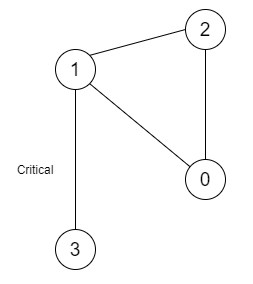
 Data Structure
Data Structure Networking
Networking RDBMS
RDBMS Operating System
Operating System Java
Java MS Excel
MS Excel iOS
iOS HTML
HTML CSS
CSS Android
Android Python
Python C Programming
C Programming C++
C++ C#
C# MongoDB
MongoDB MySQL
MySQL Javascript
Javascript PHP
PHP
- Selected Reading
- UPSC IAS Exams Notes
- Developer's Best Practices
- Questions and Answers
- Effective Resume Writing
- HR Interview Questions
- Computer Glossary
- Who is Who
Critical Connections in a Network in C++
Suppose there are n servers. And these are numbered from 0 to n-1 connected by an undirected server-to-server connections forming a network where connections[i] = [a,b] represents a connection between servers a and b. All servers are connected directly or through some other servers. Now, a critical connection is a connection that, if that is removed, it will make some server unable to reach some other server. We have to find all critical connections.
So, if the input is like n = 4 and connection = [[0,1],[1,2],[2,0],[1,3]],

then the output will be [[1,3]]
To solve this, we will follow these steps −
Define one set
Define an array disc
Define an array low
Define one 2D array ret
Define a function dfs(), this will take node, par, one 2D array graph,
-
if node is in of visited, then −
return
insert node into visited
disc[node] := time
low[node] := time
(increase time by 1)
-
for all elements x in graph[node]
-
if x is same as par, then −
Ignore following part, skip to the next iteration
-
if x is not in visited, then −
dfs(x, node, graph)
low[node] := minimum of low[node] and low[x]
-
if disc[node] < low[x], then −
insert { node, x } at the end of ret
-
Otherwise
low[node] := minimum of low[node] and disc[x]
-
-
From the main method, do the following −
set size of disc as n + 1
set size of low as n + 1
time := 0
Define an array of lists of size graph n + 1
-
for initialize i := 0, when i < size of v, update (increase i by 1), do −
u := v[i, 0]
w := v[i, 1]
insert w at the end of graph[u]
insert u at the end of graph[w]
dfs(0, -1, graph)
return ret
Let us see the following implementation to get better understanding −
Example
#include <bits/stdc++.h> using namespace std; void print_vector(vector<vector<auto> > v){ cout << "["; for(int i = 0; i<v.size(); i++){ cout << "["; for(int j = 0; j <v[i].size(); j++){ cout << v[i][j] << ", "; } cout << "],"; } cout << "]"<<endl; } class Solution { public: set<int> visited; vector<int> disc; vector<int> low; int time; vector<vector<int> > ret; void dfs(int node, int par, vector<int> graph[]) { if (visited.count(node)) return; visited.insert(node); disc[node] = low[node] = time; time++; for (int x : graph[node]) { if (x == par) continue; if (!visited.count(x)) { dfs(x, node, graph); low[node] = min(low[node], low[x]); if (disc[node] < low[x]) { ret.push_back({ node, x }); } } else{ low[node] = min(low[node], disc[x]); } } } vector<vector<int> > criticalConnections(int n, vector<vector<int> >& v) { disc.resize(n + 1); low.resize(n + 1); time = 0; vector<int> graph[n + 1]; for (int i = 0; i < v.size(); i++) { int u = v[i][0]; int w = v[i][1]; graph[u].push_back(w); graph[w].push_back(u); } dfs(0, -1, graph); return ret; } }; main(){ Solution ob; vector<vector<int>> v = {{0,1},{1,2},{2,0},{1,3}}; print_vector(ob.criticalConnections(4,v)); } Input
4, {{0,1},{1,2},{2,0},{1,3}} Output
[[1, 3, ],]

